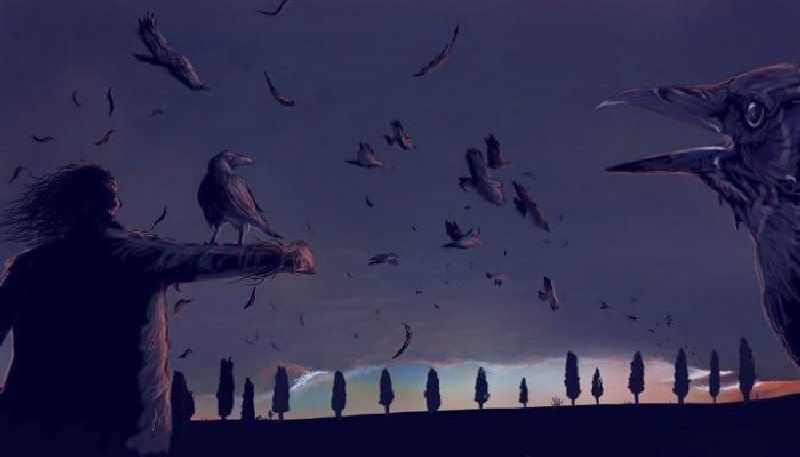(11) Celtic Folklore
Ravens and Crows appear to be interchangable in their use in the Celtic mythologies. That is not to say that the Celts weren't able to differentiate between them, but that they were viewed as having the same role within the traditions.
They are viewed in two different ways. Firstly, as a symbol of war, of prowess in battle, devourer of carrion. Probably the most famous Raven Goddess is the Morrigan, (equated with Macha and Badh in the Tochmarc Emire who are seen as hooded crows). The Corvids are the main carrion birds of Britain and Ireland, so the sight of them on the battlefield, striping the flesh from the corpses of warriors, would be an image to stick in the mind of the survivers.
Secondly, they can be seen as a provider of prophetic omens and oracles. The Celts, like various other peoples performed Ornithomancy as a means to foretell the future. Many birds were used but the Corvids more than any other. The Morrigan, the Raven Goddess herself, offers many prophetic utterances, including this one, a vision of the end of the world:-
..I shall not see a world which will be dear to me; summer without blossoms, cattle will be
without milk, women without modesty, men without valor, conquests without a king;Woods
without mast, sea without produce; False judgements of old men, false precedents of
lawyers, every man a betrayer, every son a reaver. The son will go to the bed of his father, the
father will go to the bed of his son. Each his brother's brother-in-law. He will not seek any
woman outside his house; An evil time, son will deceive his father, daughter will deceive her
mother"
Other to actually prophecies, the future could be divine from the actions, the flight or the calls of ravens, and a large amount of Raven-lore was built up, with the direction and sound been interpreted as different outcomes.
From the evidence, Raven-Gods wouldn`t appear to be a Universal Concept amongst the Celts. Lugus, the Gaulish Lugh, was associated with ravens in ancient times. Lyon, France (formally Lugudunum) was said to have been founded when Ravens settled on the site. This was seen as a favorable omen and the city was built. Early coins from the city show the Patron God accompained by ravens.
The most obvious candidate for a Raven God comes from Brythonic sources, Bran Bendigeidfran. Bran means Raven, and Bendigeidfran, though probably derived from other sources referring to his Wondrous Head, means Blessed Raven. Popular tradition links him to ravens through his association with the White Mount (Tower Hill). However, apart from his name and later folk-tales there does not seem to any real evidence allowing us to view him as a Raven God.
Ravens also feature in the Dream of Rhonabwy. In the tale, the army of Owein consists of three hundred ravens. It is of interest that Owein's mother is Morgan, who's name is cognate with the Gaelic Morrigan, the Raven Goddess.

![[Go to Site Index]](http://i6.photobucket.com/albums/y225/Abramelinn/Banner_Crow4.jpg)

<< Home